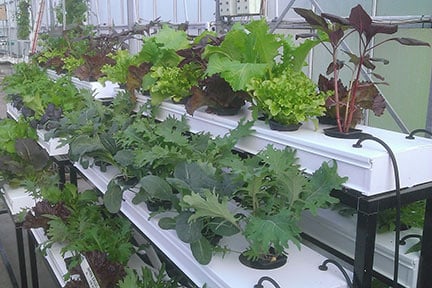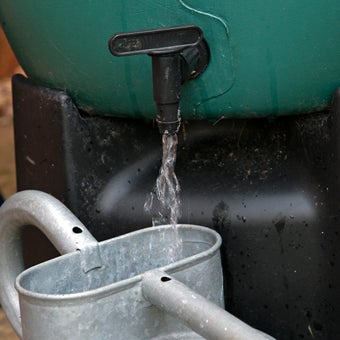
Quick facts
Suitable for - All plants but usually salad vegetables such as tomatoes and peppers
Timing - Spring to autumn; winter if artificial light is available
Difficulty - Difficult
Suitable for...
Any plant can be grown hydroponically but the method is most widely used to produce greenhouse crops; cucumbers, peppers and tomatoes for example. Florists’ roses are an example of cut flower production.
All plant roots need oxygen (air) and the root zone in hydroponic cultivation must not only be moist and nutrient-rich but must also be very well . Roots of most plants will die in stagnant water.
Hydroponic techniques
Hydroponic systems can be divided into two basic types:
- Those requiring aggregates or other porous rooting media (substrate) to support the plant roots - sometimes referred to as hydroculture.
- Those not needing aggregates to support the plant roots - the most widely used term being nutrient film technique (NFT).
Aggregate or substrate systems (including other porous media)
At its simplest hydroponics can be a plant growing in a pot of inert aggregate (such as ) and given water containing a liquid fertiliser from a watering can sufficiently often that is does not dry out. The spaces between the aggregate contain air so that roots do not suffocate.
In practice hydroponics is a bit more sophisticated. Many plants are usually watered via a drip system fed with a pump from a stock tank of nutrient solution. The nutrient solution can run to waste but it is less expensive, and less potentially polluting, to recirculate the nutrient solution via a trough below the plants that runs back to the stock tank.
Commercial tomatoes for example are grown in ‘pillows’ of rockwool drip fed with and the nutrient solution re-used. A variant of this is ebb and flow where the plant containers (filled with rooting media) are stood in a trough or basin that is periodically flooded with nutrient solution, which is then allowed to drain back to a stock tank.
The nutrient solution is a balanced mix of major nutrients (nitrogen, phosphorus, potassium, magnesium and sulphur) and a very low concentration of minor nutrients or trace elements; copper, boron, iron, manganese, molybdenum and zinc.
The pH is crucial and a meter or at least test papers is required. Citric acid is used to lower pH and baking soda is used to raise pH, although proprietary materials are offered. A pH of 5.8-6.2 is usually aimed for.
Nutrient solutions can be made up from straight chemicals such as potassium nitrate and magnesium sulphate or bought ready-made. As plants remove water nutrient solutions get stronger and can become so concentrated or ‘salty’ that roots can be damaged. This can be assessed by testing the electrical conductivity of the solution with a conductivity meter, and adding water as required. However, even with careful monitoring the nutrient balance changes and every two weeks or so it is advisable to discard the solution and make up fresh. The discarded solution can be watered onto garden soil as a fertiliser.
Aggregate-free systems (including nutrient film technique)
Dispensing with the growing media is entirely possible and cuts the costs and labour of growing.
One of the first ways of doing this was nutrient film technique. Here nutrient solution is allowed to trickle along gently sloping covered gutters. Plants are grown in small pots or cubes of rockwool and placed at intervals in the gutters. Their roots form a thick mass in the humid, well gutters and very strong plant growth can result. The surplus nutrient solution trickles back to a stock tank and a pump is used to recirculate it. If the pump stops the plants quickly die as there is no supporting medium to moisture to allow plants to survive until the nutrient solution circulation can be restored.
Again, as above, pH and conductivity must be monitored and maintained and nutrient solution renewed form time to time.
Although now little used in commercial horticulture, nutrient film technique is still used for teaching and home gardening.
A variant of this is aeroponics where the roots grow in a chamber below the plants where a drizzle of nutrient solution periodically applied by a suitable pump and spray nozzle(s). As with nutrient film technique any pump failure can quickly damage plants.

References
Books
Hydroponics for the Home Grower (31 Mar 2015), Howard M. Resh, CRC Press, ISBN-10: 1482239256, ISBN-13: 978-1482239256
Complete Guide for Growing Plants Hydroponically (2014), J. Benton Jones, CRC Press, ISBN: 978-1-4398-7668-8
A selection of books are available from the RHS Lindley Library (by post for RHS members if necessary).
Web Pages
A selection of web pages from educational institutions:
Hydroponics in the Classroom. University of Florida Accessed 8/12/2015
Hydroponics, Oklahoma Cooperative Extension Service Accessed 8/12/2015
Home Hydroponics, Virginia Co-operative Extension Accessed 8/12/2015
Please note that search engines will return numerous results for ‘hydroponics’ many of which appear to be linked to the illegal (in the UK) growing of cannabis. The RHS does not in any way approve of illegal activities, but the materials and equipment offered do have a legitimate use in cultivating garden plants.










